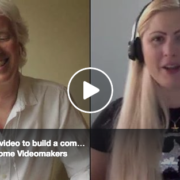How to introduce yourself on video so that it matters
When you introduce yourself & your work do you make people feel like they’re back in high school?
Did you find high school painful? When you were a student would you have been in favor of abolishing your school? (yes, I would’ve)
My own high school years were not pretty. I went to what was supposed to be the finest high school in the country. Phillips Andover Academy. At least that was the myth. In reality the place felt like it was doing its best to drive a bunch of round pegs through square holes. (If you’ve seen the film, Dead Poets Society, then you have some sense of the atmosphere).
In the worst of my classes, the teaching (read: lecturing) was a one-way street. Unless you were called on, there was no engagement. Spontaneity was frowned on. We were placed in required seats, in rows, and made to be mostly passive consumers of required subjects. While having to sit through seemingly endless lectures I recall thinking, “I could find a better way to teach than this – and do a better job than these guys.” (note: when I was a student at Andover, the school was all male, and the teachers were all guys – I know, right? – ugh).
There was one thing that saved me
Photography. By my third year I found my way into the school’s photo lab and basically started spending as much time as I could making images. It was my escape. I was inspired by the world of photojournalism and intrigued by how a single image could capture an entire story. I’ve been following my passion for image making ever since.
But there was another aspect of photography that made a world of difference. The learning was all about doing. The discovery, exploration and education was almost entirely experiential. My two photography teachers became facilitators and guides. I was constantly being asked to try things out on my own – and learn by doing. I loved it. And I thrived. And, because of my level of engagement, I developed a trusting relationship with my photography teachers who became my first true mentors.
So why does this matter?
Let’s say you have a passion, some enterprise or project, that you’re trying to make happen. You offer a unique solution to a problem that a lot of people want help with and you’re inspired to help them out. You’re super talented at what you do and you know that in order to succeed you need to build a following – a community of people who engage with you and your work.
Sound like you?
All you need to do now is teach people about what you offer. As soon as they learn all about your product, your features & services – they’ll start hiring you or buying your thing – right? Well, not exactly.
This is where the problem is.
Take a look at the landscape of how almost everyone (whether a small business or a single freelancer or a social entrepreneur) lets people know about their work.
They end up making me feel a lot like I’m back in my high school history class. Their teaching (read: marketing) is all one way – and it’s all about them. There’s no relevance (to me). (I’m thinking, “Why should I care about this?” and “Why should I pay attention?”)
“But,” you say, “What about social media? Surely having more ways to connect and so many more connections gives us more chances for engagement, right?”
If anything, social media has only made things worse. Facebook, Twitter, Instagram and Pinterest have turned us all into one-way broadcasters – creating a fire hose of endless information – that’s all about us.
Here’s the brutal truth: when it comes to the great work you do – nobody cares. People don’t want to hear from you about you. What they care about is their own stuff – and the problems they’re dealing with. If you want to engage with them – building trust and getting them involved with the thing you’re most passionate about – there’s only one way you can do this.
You need to give them the experience of getting the solution they’re looking for.
It doesn’t matter if your passion is dog grooming or design or dealing with climate change – if you’re going to build a following of people who share your passion and who want to work with you, you need to provide an experience of getting the solution.
[bctt tweet=”Want people to follow your passion? Provide the experience of getting the solution you provide.”]
After all those formative years as a student, I moved to the Pacific Northwest where I became an experiential educator. I developed an outdoor program that eventually became part of the Pacific Crest Outward Bound School. The methodology was all about learning by doing. And it involved building trust and engagement and helping groups of young people work together towards a common goal.
All good lessons for today’s entrepreneurs…
Case Study: Geordie Wood and Fader
 In the video above, made for FADER and Visual Supply Company, Geordie Wood, photo director for The FADER, shares how Visual Supply Company’s new ipad app, Journal will allow more people to see, view, and contribute to photography as a whole. But Wood doesn’t talk about Journal so much as he talks about his own process as a photographer – and what he sees as the value that Journal provides to photographers (and photography lovers) everywhere.
In the video above, made for FADER and Visual Supply Company, Geordie Wood, photo director for The FADER, shares how Visual Supply Company’s new ipad app, Journal will allow more people to see, view, and contribute to photography as a whole. But Wood doesn’t talk about Journal so much as he talks about his own process as a photographer – and what he sees as the value that Journal provides to photographers (and photography lovers) everywhere.
We’re engaged, not because of the features & benefits of the product but because of Wood’s journey and vision.
I hope the process will provide you some experience of how to create engagement and build community for that thing that you’re most passionate about.
If you’d like to learn more techniques to engage people and how to get clients from your live video then watch this short tutorial on ‘How To Attract Clients On Video’ and learn my 3-step formula for generating leads with live video.









